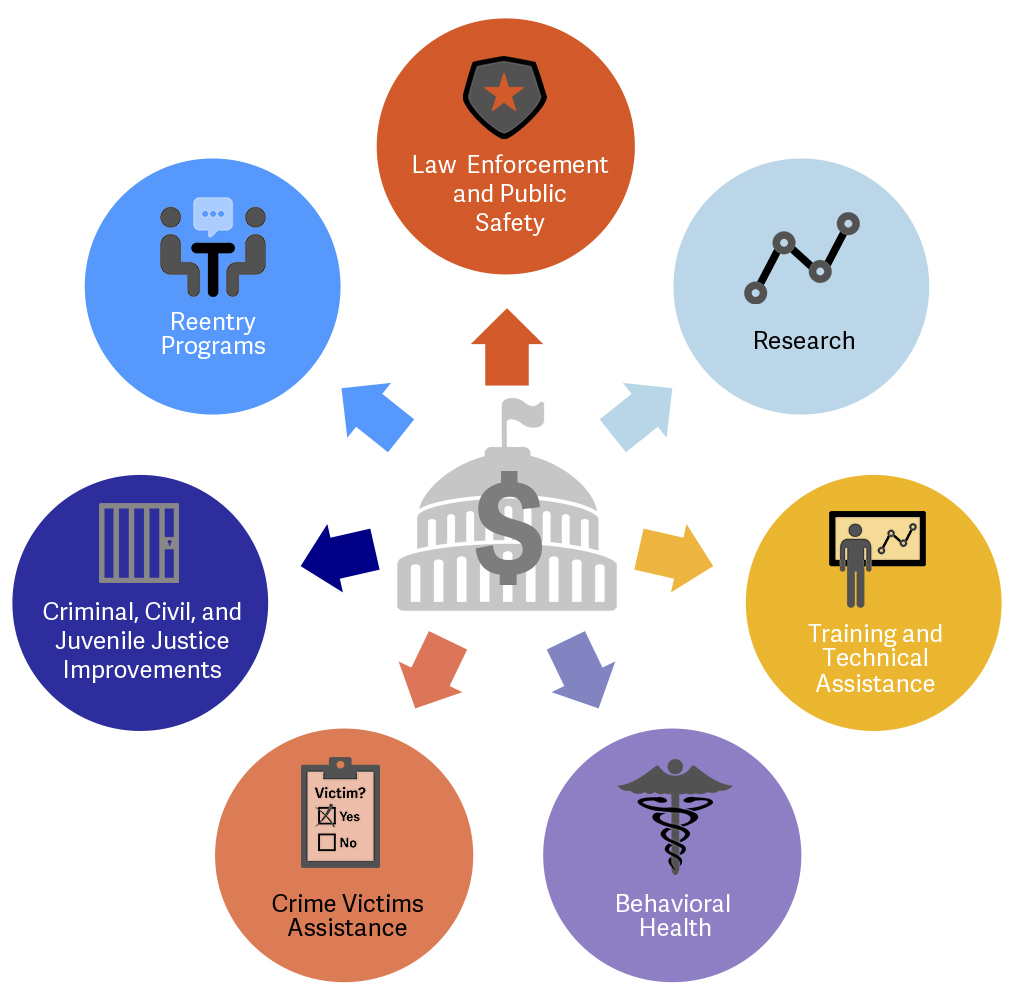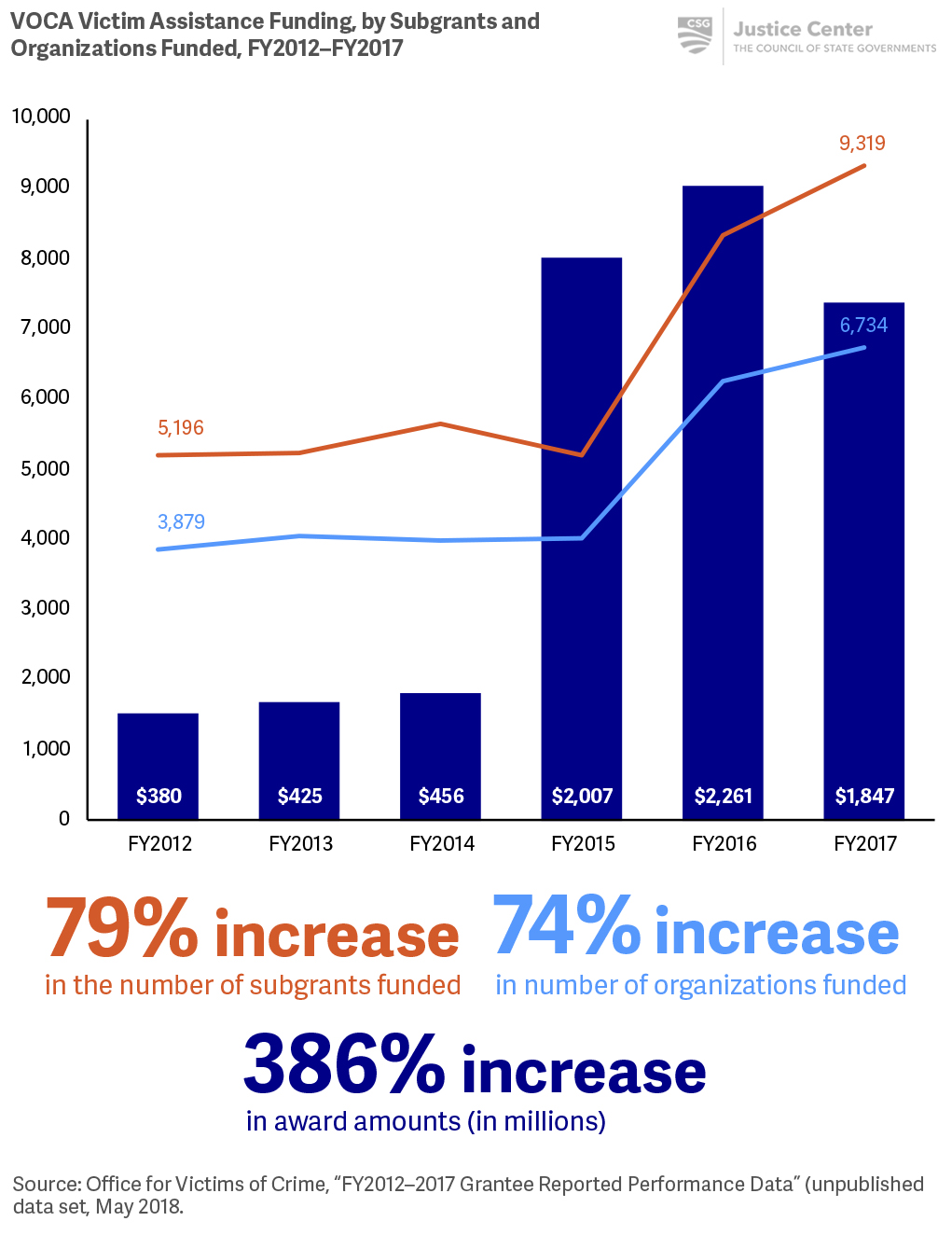Part 3, Strategy 3
Action Item 3: Leverage federal resources to drive innovation.
Why it matters
State and local policymakers need to not only evaluate how they are currently spending their state public safety dollars, but also assess how they are spending federal public safety dollars. To ensure that federal funding has the maximum impact on public safety, state and local governments need to identify gaps in funding after reinvesting state dollars to determine how federal dollars can be used to address them.
Further, both state and local leaders can work to leverage these federal resources to drive innovation in law enforcement, behavioral health care, victims’ services, and criminal justice. Federal programs can provide funding support and technical assistance to help states pilot new approaches and adopt evidence-based practices based on the latest research.
The Office of Justice Programs (OJP) under the Department of Justice provides millions of dollars in technical assistance and direct financial support to state, local, and tribal governments, and nonprofit organizations each year to advance public safety priorities. OJP provides a range of funding opportunities, from the Second Chance Act grants and the Justice Reinvestment Initiative to Victims of Crime Act formula funding grants to states for victim assistance and state compensation. The Substance Abuse and Mental Health Services Administration within the Department of Health and Human Services also provides funding for behavioral health-related public safety strategies. (See Additional Resource box that follows for more information.)
What it looks like
- Analyze current spending on public safety priorities and identify any gaps in funding.
- Assess how federal funds are currently spent to determine whether funding is directed to public safety priorities.
- Identify opportunities to pursue federally-funded efforts that align with public safety priorities and drive innovation.
- See Case Study: Illinois leverages federal funds to serve historically underserved victims of crime
- See Case Study: States enhance victim compensation programs
Key questions to guide action
- What federal resources does your jurisdiction currently receive and how are they being allocated?
- Do state and local governments collaboratively identify public safety priorities?
- Are there federal efforts that can provide funding and/or technical assistance to help address the state’s biggest public safety challenges and drive innovation?
- How can federal funding opportunities support local governments in addressing their most pressing public safety issues?
Use the information that follows to inform your answers to these questions.
Federal funding can help supplement state budget allocations for public safety priorities and help pilot innovative programs, reduce recidivism, and advance justice.

Additional Resources
Department of Justice grants
The United States Department of Justice (DOJ) disburses public safety grants primarily through three agencies: The Office of Justice Programs (OJP), the Office of Community Oriented Policing Services (COPS), and the Office on Violence Against Women (OVW), and each has a website that can help interested parties identify potential funding opportunities.
- The DOJ Program Plan website identifies current funding opportunities, when they are available, and total available funding amounts.
- The OJP Program Plan Initiatives website allows users to search for criminal justice and juvenile justice initiatives offered by OJP bureaus and program offices based on subject matter, applicant eligibility, and program plan. OJP also administers the Office of Victims of Crime (OVC), which oversees a variety of grants to help victims and victim services providers, including funding for victim compensation, assistance, and notification.
- The COPS Office awards grants to hire community policing professionals, develop and test innovative policing strategies, and provide training and technical assistance to community members, local government leaders, and all levels of law enforcement.
- The OVW administers grant programs to help provide victims with the protection and services they need to pursue safe and healthy lives, while simultaneously enabling communities to hold people accountable.
Health and Human Services grants
- The U.S. Department of Health and Human Services Substance Abuse and Mental Health Services Administration (SAMHSA) offers grants and funding that support programs related to criminal justice.
Grants.gov
The Grants.gov website is another resource for finding and accessing federal financial assistance. The website helps individuals and organizations find and apply to grants that are available across the federal government.
Additional Resources
Victims of Crime Act formula grants
Since 1984, the federal government has provided Victims of Crime Act (VOCA) formula funding to each state’s administering agency (SAA) to determine how best to meet the needs of crime victims. Millions of dollars in state and federal funding are distributed by states to nonprofit organizations, local governments, colleges and universities, hospitals, and other entities to serve hundreds of thousands of victims each year.
The amount of federal funds available to states through VOCA has grown exponentially since FY2015 due to increases in the Crime Victims Fund, the congressional fund from which VOCA originates. In FY2018, the maximum amount of funding available for distribution from the Crime Victims Fund is $4.4 billion.[66] A funding formula determines the amount of money distributed from the Crime Victims Fund to various programs, including the VOCA Assistance and Compensation Formula Grant Programs. The VOCA Assistance Formula Grant Program provides funding to jurisdictions based on population, while the VOCA Compensation Formula Grant Program is based on the amount of state contributions into the compensation program. As such, state victim assistance programs received a significant increase in funding in recent years as the amount of money available for distribution from the Crime Victims Fund increased, while compensation programs largely did not benefit without an increase in state funding.
Direct assistance to crime victims funded through the VOCA Assistance Formula Grant Program includes crisis counseling, telephone and onsite information and referrals, criminal justice support and advocacy, shelter, therapy, and additional assistance. Funds may also be used to develop new programs that address emerging needs, gaps in services, and training of victim service advocates.
The VOCA Compensation Formula Grant Program provides funding to supplement state compensation programs that provide financial assistance and reimbursement to victims for some of their expenses that result from a crime, including medical and dental care, counseling, funeral and burial expenses, and lost wages and income. Compensation programs may also reimburse victims for other types of expenses related to their victimization, such as travel, temporary lodging, crime scene cleanup, and dependent care.
For additional information, see the Office of Victims of Crime Grants and Funding.
VOCA victim assistance funding has more than quadrupled in recent years, allowing states to fund more victim service organizations and provide more subgrants to those organizations.

Federal funding for each state’s victim compensation program has varied greatly in recent years.

The federal “Consolidated Appropriations Act, 2018” establishes the cap on the Crime Victims Fund in FY2018 at $4.436 billion, the highest level ever.
Case Study
Illinois leverages federal funds to serve historically underserved victims of crime
In 2017, the Ilinois Criminal Justice Information Authority (ICJIA), which oversees federal and state assistance programs, completed a statewide assessment of victim services in Illinois that included analyzing crime and victimization data and surveying victims and victim service providers. Based on that assessment, the Illinois Ad Hoc Victim Services Committee identified crime victim needs, service gaps, and capacity limits of victim service providers in the state. The committee then identified 12 funding priorities to address those needs, gaps, and capacity issues that will guide public notices for competitive grants and statewide funding decisions for the next three years.[63]
In 2018, ICJIA announced a funding opportunity that addresses several key funding priorities related to services for underserved groups, the need for longer-term mental health services, and the importance of trauma-informed and trauma-focused services and programs. Applicants could request up to $1.1 million in federal funding to serve historically underserved or marginalized victims of violent crime and their families through trauma recovery centers. The grants use a portion of Illinois’s share of federal Victims of Crime Act (VOCA) funds to support application of the evidence-based trauma recovery center model, which provides coordinated clinical and case management services for adult and/or minor victims of violent crime and their families who typically do not access services due to individual and cultural barriers.[64]
[63] Jaclyn Houston-Kolnik et al., Ad Hoc Victim Services Committee Research Report, (Chicago, IL: Illinois Criminal Justice Information Authority, 2017).
[64] Illinois Criminal Justice Information Authority, “Uniform Notice of Funding Opportunity, Victims of Crime Act: Trauma Recovery Centers” (Chicago, IL: Illinois Criminal Justice Information Authority, 2017).
Case Study
States enhance victim compensation programs
Every state operates a crime victim compensation program to help cover expenses and losses resulting from violent crimes or abuse. Eligibility requirements vary slightly by jurisdiction, but in most cases, victims must promptly report the crime and file a claim and cooperate with law enforcement and prosecutors. Any expenses not covered by compensation may be covered by restitution. Victims cannot receive restitution and compensation for the same damages.
States typically fund crime victim compensation programs through fines and fees collected from people convicted of crimes and people who receive traffic violations. Some states allocate general state funds to the compensation program as well. The VOCA Compensation Formula Grant Program uses a 60-percent match calculation to determine a state’s award. Federal VOCA formula awards to state compensation programs often fluctuate as state spending changes.
- Beginning in 2017, CSG Justice Center staff analyzed data showing that the availability of Crime Victim Compensation benefits for family members of homicide victims in Iowa were not uniform. In 2018, the state enacted legislation to update statutory language to ensure that family members of homicide victims would be treated equally.
- Beginning in 2017, CSG Justice Center staff assessed Michigan’s victim compensation program data and compared compensation statutory language with neighboring states to identify gaps in the state’s current compensation program. The CSG Justice Center produced a report that highlighted opportunities to improve Michigan’s Crime Victim Compensation Program in three areas: expansion of eligibility requirements to allow more victims to apply for compensation; expansion and improvement of existing benefits to meet the evolving and complex needs of victims; and options to make the program more accessible through collaboration and technology. In 2018, Michigan is considering draft legislation to update victim compensation statutory language and provide more resources to crime victims.
- In Missouri, onerous requirements to receive victim compensation effectively restrict access to compensation benefits for those who need it most. In FY2014, applications for victim compensation were filed for fewer than 5 percent of violent crimes committed that year, and 40 percent of those claims were denied reimbursement for administrative reasons.[65] The state passed legislation in 2018 to expand eligibility requirements to include more victims of violent crime; enhance existing benefits to meet the growing needs of victims who have already received all other public benefits to which they are entitled; and address barriers, including replacing cumbersome and antiquated application and communication processes with modern technologies, such as allowing electronic submission of applications.
[65] Email correspondence between CSG Justice Center and Missouri Department of Public Safety, October 17, 2017.
